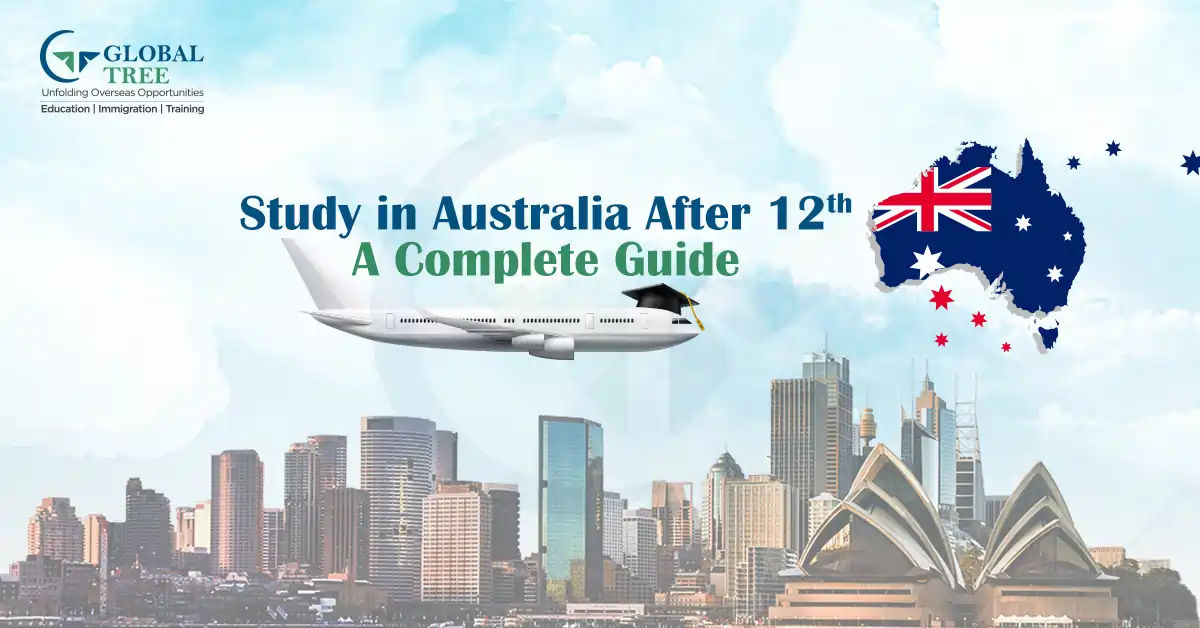A Complete Guide to Study in Australia after 12th

- Introduction
- A list of Top Universities to choose in Australia after 12th
- What are the eligibility criteria for Student visa application in Australia?
- What are the English Language Proficiency Tests to study in Australia?
- What are the Health requirements for Australia student visa?
- How much funds do you need to study in Australia?
- Scholarships and funding options in Australian universities
- Conclusion
Introduction
Australia is one of the most popular destinations for study and work and offers a diverse range of career opportunities.
Graduates often find opportunities in both metropolitan and regional areas, with various programs encouraging employment in less populated regions.
Understanding the Australian job market, the demand in specific sectors, and networking are crucial for a successful career in Australia.
A list of Top Universities to choose in Australia after 12th
Australian universities are globally recognized for their quality education and research facilities. They offer a wide range of undergraduate programs catering to different interests and career goals.
| University Name | Location | Popular Courses | Unique Features/Rankings |
|---|---|---|---|
|
University of Melbourne |
Melbourne |
Arts, Science, Commerce, Engineering |
Ranked 1st in Australia (QS World Rankings 2023) |
|
Australian National University |
Canberra |
Law, Economics, Engineering |
Renowned for research and political studies |
|
University of Sydney |
Sydney |
Business, Medicine, Music |
Known for its heritage campus and diversity |
|
University of Queensland |
Brisbane |
Psychology, Agriculture, Biotechnology |
Leading in research initiatives |
|
Monash University |
Melbourne |
Pharmacy, Law, Engineering |
Largest university in Australia |
|
University of New South Wales |
Sydney |
Business, Engineering, Arts |
Strong emphasis on scientific research |
|
University of Western Australia |
Perth |
Medicine, Arts, Business |
Member of the prestigious Group of Eight |
|
University of Adelaide |
Adelaide |
Wine & Food Science, Engineering |
Known for agricultural sciences and research |
|
RMIT University |
Melbourne |
Design, Architecture, IT |
Strong industry connections |
|
University of Technology Sydney |
Sydney |
Communication, Design, IT |
Modern approach to education and learning |
There are popular universities like the University of Sydney, Australian National University, and University of Melbourne which provide courses in fields such as Business, Engineering, Science, Arts, and more.
Each university has its unique strengths and specializations, making it important for students to research and choose based on their career aspirations and interests.
Additionally, Australian universities often have strong industry connections, providing students with practical experience and networking opportunities.
What are the eligibility criteria for Student visa application in Australia?
Obtaining a student visa is a critical step in the journey to study in Australia.
The process involves several steps, including acceptance from a recognized educational institution, proof of sufficient funds, and English language proficiency.
| Step | Description | Documents/Requirements |
|---|---|---|
|
Choose a Course and Institution |
Decide on the course and educational institution you wish to attend in Australia. |
Course and university acceptance letter. |
|
Check Visa Requirements |
Understand the specific requirements for the Australian student visa (subclass 500). |
Valid passport, COE (Confirmation of Enrolment), proof of welfare arrangements (if under 18). |
|
English Language Proficiency |
Demonstrate proficiency in English. |
IELTS, TOEFL, PTE, or similar test scores. |
|
Financial Requirements |
Show evidence of sufficient funds to cover tuition, living costs, and travel. |
Bank statements, scholarship letters, financial aid documents. |
|
Health Insurance |
Obtain Overseas Student Health Cover (OSHC). |
Health insurance policy document. |
|
Visa Application |
Complete and submit the online visa application. |
Completed visa application form, application fee, all required documents. |
|
Health Checkup and Biometrics |
Undergo a health examination and provide biometric information. |
Medical examination reports, biometric information. |
|
Visa Outcome |
Wait for the decision on your visa application. |
Notification of visa approval or rejection. |
|
Pre-departure |
Prepare for your travel to Australia once the visa is approved. |
Arrange for travel, accommodation, and other logistics. |
Applicants must also meet certain health and character requirements. It’s advisable to start the visa application process well in advance and ensure all documentation is accurate and complete.
The Australian government’s Department of Home Affairs website provides detailed information and guidelines for the student visa application process.
What are the English Language Proficiency Tests to study in Australia?
To get into your preferable university in Australia after 12th, you are required to take the English language proficiency tests to prove your proficiency score.
Here is the list you need to look at:
- IELTS (International English Language Testing System)
- TOEFL (Test of English as a Foreign Language)
- PTE Academic (Pearson Test of English Academic)
- CAE (Cambridge Advanced English)
- OET (Occupational English Test)
- CPE (Cambridge Proficiency English)
(Read More: Do Australian Universities accept PTE Score of 48 to 70?)
| Test Name | Description | Format | Scoring | Recognized By Australian Universities |
|---|---|---|---|---|
|
IELTS |
A popular global English language test assessing reading, writing, listening, and speaking skills. |
Both paper-based and computer-delivered options. |
Scored on a band scale of 1-9. |
Widely accepted by most universities. |
|
TOEFL |
Measures English language proficiency in academic settings. |
Internet-based and paper-based formats. |
Scores range from 0 to 120 for the internet-based test. |
Broadly recognized by Australian universities. |
|
PTE Academic |
Focuses on English skills in an academic context, using automated scoring. |
Computer-based test. |
Overall score ranges from 10 to 90. |
Increasingly accepted by universities in Australia. |
|
CAE |
Assesses English language ability at an advanced level. |
Both computer-based and paper-based tests available. |
Grade scale from A (highest) to C (minimum required level). |
Accepted by many Australian institutions. |
|
OET |
Specifically designed for healthcare professionals. |
Paper-based test. |
Grades A (highest) to E (lowest). |
Recognized by some Australian universities, especially for healthcare courses. |
|
CPE |
The most advanced qualification, demonstrating proficiency in English. |
Both paper-based and computer-based tests. |
Pass at Grade C, B, or A. |
Accepted by several universities in Australia. |
What are the Health requirements for Australia student visa?
Australia has strict health requirements for incoming students. This often includes a health examination and having health insurance coverage.
The Overseas Student Health Cover (OSHC) is a specific type of insurance for international students, covering medical and hospital expenses.
Ensuring you meet these health requirements is essential for both Australia student visa approval and personal wellbeing.
How much funds do you need to study in Australia?
Studying in Australia can be an expensive endeavour. Tuition fees vary widely depending on the course and university.
Living expenses, including accommodation, food, transportation, and other personal costs, also needs to be factored in.
It’s important for students and their families to have a realistic understanding of the financial requirements and plan accordingly, including potential part-time work and savings.
The cost of studying in Australia after the 12th grade can be broken down into several key categories.
Here's a list outlining the primary expenses that you need to consider:
1. Tuition Fees: These vary widely based on the university and course. For example, arts and education courses may cost around AUD 20,000 to AUD 30,000 per year, while medical and engineering courses can be higher, often exceeding AUD 30,000 per year.
2. Living Expenses: Includes accommodation, food, transportation, and personal expenses. On average, cost of living in Australia can range from AUD 20,000 to AUD 27,000 per year.
3. Accommodation Costs: Options include on-campus residence, renting an apartment, or homestays. Costs can vary from AUD 100 to AUD 400 per week.
4. Health Insurance: As previously mentioned, Overseas Student Health Cover (OSHC) is mandatory for student visa holders, costing approximately AUD 500 to AUD 1,000 per year.
5. Books and Supplies: Depending on the course, the cost for books and other academic supplies can range from AUD 500 to AUD 1,000 per year.
6. Visa Application Fee: The cost for an Australian student visa (subclass 500) is approximately AUD 620.
7. Travel Expenses: Includes flights to and from Australia and any internal travel. Costs will vary depending on your country of origin and travel habits.
8. Miscellaneous Expenses: Can include mobile phone, internet, entertainment, and other personal expenses, typically ranging from AUD 1,000 to AUD 2,500 per year.
9. Emergency Funds: It's advisable to have some funds set aside for unexpected expenses or emergencies.
10. Part-time Work: Many students take up part-time or internships in Australia to offset some of the living expenses. It's important to note that there are restrictions on the number of hours international students can work while on a student visa.
Scholarships and funding options in Australian universities
Many Australian universities offer scholarships and bursaries to international students based on academic merit, financial need, or specific talents.
These can significantly reduce the financial burden. Additionally, there are government scholarships like the Australia Awards and various external funding options available.
Here's a list of common types of scholarships and funding opportunities available to international students in Australia:
1. Merit-Based Scholarships: Awarded based on academic excellence, these scholarships can cover partial or full tuition fees. Some may also provide a stipend for living expenses.
2. Need-Based Scholarships: Designed for students who demonstrate financial need. These scholarships in Australia can cover tuition fees, living expenses, or both.
3. Research Scholarships: For students pursuing research-based postgraduate degrees (like a Ph.D.), these scholarships often cover tuition fees and provide a living allowance.
4. Country-Specific Scholarships: Some scholarships target students from specific countries or regions, aiming to promote cultural exchange and educational links.
5. University-Specific Scholarships: Many Australian universities offer their own scholarship programs for international students. These can vary greatly in terms of value and criteria.
6. Australian Government Scholarships: Notably, the Australia Awards, Endeavour Scholarships and Fellowships, and Research Training Program (RTP) provide comprehensive scholarships including tuition fees, living expenses, and travel costs.
7. Faculty or Course-Specific Scholarships: Offered within specific faculties or for certain courses, often targeting students with exceptional skills or interests in that field.
8. External Funding Organizations: Various international organizations, NGOs, and private foundations offer scholarships for studying abroad, including in Australia.
9. Work-Study Programs: Some universities offer work-study options to international students, allowing them to work part-time on campus to support their studies.
10. Internships and Industry Sponsorships: Opportunities where businesses or industry bodies sponsor students in relevant fields, sometimes including work placements.
(Read More: Explore the top Level-1 Universities to study in Australia)
11. Scholarships for Leadership and Community Involvement: These scholarships recognize leadership skills and community involvement rather than just academic achievement.
12. Travel and Living Expense Grants: Some scholarships specifically aim to cover travel and living expenses, rather than tuition fees.
Conclusion
Planning to study abroad, especially in a country like Australia, requires careful consideration of various factors including career prospects, university selection, visa processes, financial planning, and meeting health and immigration requirements.
However, with thorough research and preparation, the experience of studying in Australia can be immensely rewarding, offering quality education, diverse cultural experiences, and excellent career opportunities.









